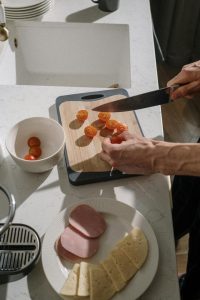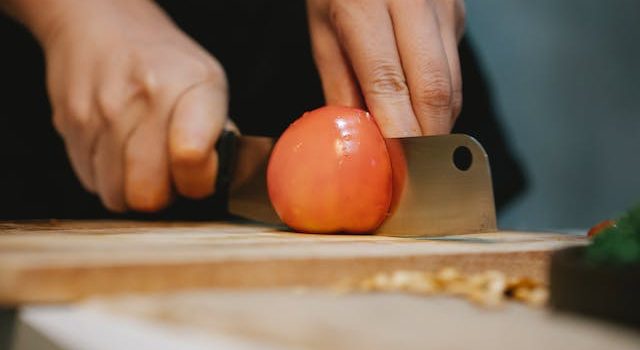
Introduction:
Culinary craftsmanship! If you’re passionate about cooking and looking to take your kitchen skills to the next level, you’ve come to the right place. In this comprehensive guide, we’ll explore advanced cutting board techniques, sourced from the Food Safety and Inspection Service (FSIS). Whether you’re a seasoned home chef or just starting your journey, these cutting board tips will help you enhance your skills and ensure a safer, more enjoyable cooking experience.
Perfect Cutting Board
Selecting the right cutting board is a crucial first step in mastering advanced culinary techniques. Here, we explore the benefits and drawbacks of various cutting board materials:
Wooden Cutting Boards:
- Pros: Elegant, knife-friendly, gentle on blades.
- Cons: Require regular maintenance (oiling).
- Best For: Fruits, vegetables, and bread.
Plastic Cutting Boards:
- Pros: Affordable, easy to clean, lightweight.
- Cons: Prone to deep cuts, potential for bacterial retention.
- Best For: Raw meat, poultry, seafood.
Bamboo Cutting Boards:
- Pros: Eco-friendly, highly durable.
- Cons: Require regular maintenance (seasoning).
- Best For: Versatile use – great for various ingredients.
Glass Cutting Boards:
- Pros: Hygienic, easy to sanitize.
- Cons: Can damage knife edges, not suitable for heavy cutting.
- Best For: Fruits, vegetables, and bread.
Maintaining Your Cutting Board
Proper maintenance is key to a safe and effective food preparation to care for and extend the life of your cutting board:
Cleaning:
- After each use, wash your cutting board with hot, soapy water.
- Use a scrub brush to remove food particles and stains.
- Sanitize the board with a solution of one tablespoon of bleach per gallon of water and allow it to air dry.
Oiling:
- Wooden and bamboo boards should be regularly oiled to prevent cracking.
- Use food-grade mineral oil or beeswax.
- Apply a thin, even layer of oil, let it sit for a few hours, and wipe off any excess.
Avoid Dishwashers:
- Never put wooden or bamboo cutting boards in the dishwasher, as the heat and moisture can cause warping and cracking.
By maintaining your cutting board properly, you ensure its longevity and keep your kitchen tasks efficient and safe.

Advanced Cutting Techniques
To truly master the art of food preparation, understanding and employing advanced cutting techniques can make a significant difference in your dishes’ presentation and flavor.
Julienne:
- Create long, thin strips of vegetables, ideal for garnishes.
- Start by making evenly spaced, parallel cuts and then slice them into thin strips.
Chiffonade:
- Achieve thin ribbons of leafy greens or herbs.
- Stack leaves, roll them tightly, and make fine cuts along the roll.
Brunoise:
- Create tiny, uniform cubes for added texture and flavor in dishes.
- Begin by dicing your ingredient into small strips, then cut crosswise into tiny cubes.
Mince:
- Produce extremely fine and uniform pieces, ideal for garlic and herbs.
- Use a rocking motion with your knife to create small, even cuts.
Bias Cut:
- Create elongated ovals or rhombus-shaped slices for unique presentation.
- Slice your ingredient at an angle, typically at 45 degrees to the cutting surface.
Pivot Chop:
- Achieve precision by using your fingers as a guide for the knife.
- Keep your fingertips tucked in and use your knuckles to guide the knife’s edge.
Special Considerations
Different types of food require specific approaches when using your cutting board to maintain food safety and flavor. Here are some guidelines for various ingredients:
Meat:
- When cutting meat, use a non-porous (plastic or glass) board for easy cleaning and sanitizing.
- Keep a separate cutting board for poultry to minimize the risk of bacterial contamination.
Fish:
- Choose a cutting board that is easy to clean and sanitize, such as plastic or glass.
- Remove fish skin and scales with a fish scaler before cutting.
Vegetables:
- Wooden and bamboo boards are excellent for cutting vegetables, as they won’t dull your knives.
- Wash vegetables thoroughly before cutting to remove dirt and contaminants.
Fruits:
- Wooden and bamboo cutting boards are perfect for fruit, providing a clean surface that won’t affect the taste.
- Rinse and scrub fruits to remove any pesticides or residues.
Bread:
- Wooden boards are ideal for cutting bread without dulling the blade.
- Use a serrated knife to achieve clean cuts.

KeyPoint:
| Material | Pros | Cons | Best For |
|---|---|---|---|
| Wood | Natural look, knife friendly | Requires regular oiling | Fruits, vegetables, bread. |
| Plastic | Easy to clean, cost-effective | Prone to deep cuts | Raw meat, poultry. |
| Bamboo | Durable, eco-friendly | Requires maintenance | Versatile use. |
| Glass | Hygienic, easy to sanitize | Damages knives | Fruits, vegetables. |
Conclusion:
In the culinary world, the cutting board is not merely a slab of wood, plastic, bamboo, or glass. It is a canvas for creativity and a cornerstone of food safety. We’ve delved into advanced techniques, maintenance practices, and key considerations for choosing the right cutting board material. As you embark on your journey to elevate your culinary skills, here are some key takeaways to keep in mind: Choose Wisely Select your cutting board material based on your cooking preferences. Wooden boards are perfect for fruits and vegetables, while plastic is ideal for raw meat and poultry. Bamboo offers versatility, and glass excels with fruits and vegetables. Maintenance Matters: Properly maintain your cutting board to ensure longevity. Regular cleaning, oiling and avoidance of dishwashers are essential steps to keep it in top shape. Advanced Techniques: Explore advanced cutting techniques like julienne, chiffonade, and mince to enhance your culinary repertoire. These skills will not only improve your dish presentation but also elevate the flavors.










